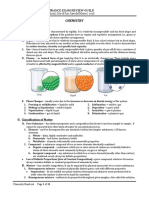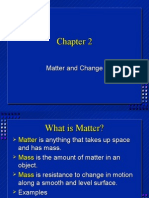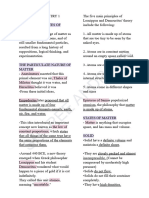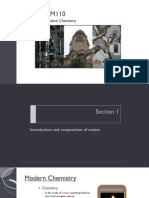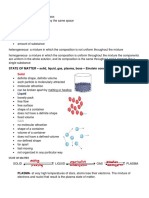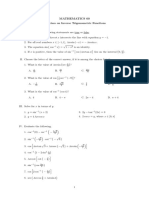GenChem 1.4
GenChem 1.4
Uploaded by
MichelleCopyright:
Available Formats
GenChem 1.4
GenChem 1.4
Uploaded by
MichelleCopyright
Available Formats
Share this document
Did you find this document useful?
Is this content inappropriate?
Copyright:
Available Formats
GenChem 1.4
GenChem 1.4
Uploaded by
MichelleCopyright:
Available Formats
Ateneo de Manila Senior High School Phases of Water
School Year 2018-2019 - Solid: x < 0ºC
- Liquid: 0ºC < x < 100ºC
General Chemistry 1 | Long Test I Reviewer - Gas: x > 100ºC
Note:
INTRODUCTION TO CHEMISTRY - higher temperature particles have higher
kinetic energy to move around freely
What is Matter? Anything that: - particles stop moving completely at
1. has mass absolute zero
2. takes up space
Mass Fourth State of Matter: Plasma
- a measure of the amount of “stuff” or - formed at high temperatures
material the object contains - ionized phase of matter as found in our sun
- don’t mistake it for weight, which is a and other stars
measure of gravity - particles are “excited”
- measured in grams or kilograms (SI unit) - plasma tv
Volume
- measure of space occupied by the object PROPERTIES OF MATTER
- “impenetrability”: matter cannot occupy
the same space at the same time Physical vs. Chemical
Physical
Phases / States of Matter - observed and measured without changed
Solid: Molecules in a fixed lattice (crystal) the material’s composition
- particles are compact - examples: color, hardness, melting point,
- no spaces between particles boiling point
Liquid: Molecules are free to move around
- small spaces between particles Property Description
- can move freely
Gas: Large spacing between molecules Brittleness ability to shatter into tiny pieces
- can be easily compressed Hardness ability to resist scratching
- spaces are larger than the particles
themselves Elasticity ability of a material to return to
its original shape after stress
Solid Liquid Gas Viscosity resistance to flow
definite definite compressible Solubility ability of a solid or gas to mix in
volume volume a liquid solvent
definite shape takes shape of takes shape of Miscibility ability of a liquid to mix in a
container container liquid solvent
small large large Luster shininess of a metal
expansion with expansion with expansion with
Conductivity ability to transfer energy (heat to
increase in increase in increase in
electricity)
temperature temperature temperature
Density measure of how tightly matter is
“packed”
Melting point temperature at which a solid
turns to liquid
Page !1 of !5 © Dane de Mata | 12-Pro
Boiling point temperature at which a liquid
boils to become a gas at a given
pressure
Malleability ability to be hammered or
beaten into thin sheets
Ductility ability to be drawn into a thin
wire
Chemical
- only observed by changing the composition
of the material
- examples: ability to burn, decompose,
ferment, rusting, tarnishing, taste Phase Diagram of Water
Triple Point: Three phases of water can
Extrinsic vs. Intrinsic co-exist here
Extrinsic / Extensive Critical Point: cannot distinguish between the
- dependent on the amount go matter in the liquid and gaseous phase
sample
- examples: mass, volume, calories
Intrinsic / Intensive
- depends on the type of matter, no the
amount present
- examples: density, hardness, melting and
boiling point
- also for different concentrations like with a
salt solution
Physical vs. Chemical Change
Physical Change
- will change physical appearance, without
changing the composition
- examples: boil, melt, cut, bend, split, crack
- can be reversible or irreversible
- phase change: may be due to the Sample Heating Curve
introduction of heat (kinetic energy) or a
sudden change in pressure in a system
Kinetic Molecular Model of Water
- below 0ºC, water solidifies
- in a solid state, water molecules are held
together in a rigid structure with larger
spaces than in liquid form (density
decreases)
Page !2 of !5 © Dane de Mata | 12-Pro
Chemical Change CLASSIFICATION OF MATTER
- a new form of matter is formed
- examples: rust, burn, decompose, ferment
- change in which one or more substances
are converted into different substances
Recognizing Chemical Change
1. Absorption or release of energy
- usually in the form of heat
- exothermic: heat is released
endothermic: heat is absorbed
2. Change in color
- when a new substance is formed, it
expected to have new properties
3. Production of gas
- bubbling, fizzing, odor change or smoke
- not always the case Element: Identity of the material
- examples: acids “eating away” metal Atom: physical manifestation
2N + 2HCl → 2NCl2 + H2 (gas)
4. Precipitation Elements
- solid that separated from the solution 1. Monoatomic
(insoluble) - elements that can exist as one atom
5. Irreversible - examples: Fe, Hg, Ag, Mg, He
- not easily reversed 2. Diatomic
- cannot be done using physical separation - unstable in their monoatomic form
- examples: H2, O2, Cl2, Br2, F2, I2, N2
Law of Conservation of Mass
- The mass of the starting materials (or Mixtures
reactants) is always equal to the mass of the - two or more substances that are not
resulting products chemically combined
- there is no change in the quantity of matter - No constant boiling point and melting point
during a chemical / physical change (based on how much of the substance)
- matter cannot be created nor destroyed, - variable composition
only transformed from one form to another - components retain their characteristic
properties
Note: - separated into pure substances by physical
- This law is not completely true: E = mc2 methods
- What is actually constant : total amount of - mixtures of different compositions may have
mass and energy; however, the change is widely different properties
mass is very negligible
Page !3 of !5 © Dane de Mata | 12-Pro
Separating Mixtures 5. Chromatography
- differences in physical properties are used - chroma means “color”
to separate mixtures - stationary phase: paper
- mobile phase: solvent (usually alcohol)
Separation Technique Property
- Liquid chromatography: a column
becomes the stationary phase instead of
Physical means (picking color and size the paper
apart, etc.) 6. Liquid-liquid Extraction
Magnetic separation magnetism - aqueous solvent and organic solvent
- two immiscible liquids (polar and non-
Sieving and Filtration particle size polar) are layered on top of each other
Decantation weight - stirred/shaken
- mixture is left to stand, particles will
Evaporation boiling point of a liquid separate and partition (dissolve) into the
and solid
preferred solvent
Distillation boiling point of two 7. Centrifugation
liquids - misnomer: called centripetal force
- can go up to 80,000 rpm (ultra
Chromatography weights/affinity to the
centrifuge)
solvent
- denser particles with settle at the bottom
Liquid-liquid extraction weight - larger particles, greater velocities
experienced
Centrifugation densities
- used with blood, DNA
Separation Techniques PROPERTIES OF GASES
1. Magnetic Separation
- involves magnets - they have mass
- used for powdered ore - easy to compress
2. Sieving/Filtration - take the shape of their container
- sieve or screen - occupy the whole container
- mesh appropriate size is used - they diffuse or move through each other
- separation of sand and gravel - they exert pressure, which is dependent on
- filtration is the same as sieving except it temperature
is done with solid and liquid mixtures
3. Decantation P = ∑ force of collisions / total surface area
- solid + liquid mixture
- liquid is allowed to settle at the bottom Kinetic Molecular Theory of Gases
- when you wash rice 1. gases consist of small particles, each with
4. Distillation mass
- boiling points must be at least 10ºC apart 2. particles move in constance, rapid, and
- liquid + liquid solutions/mixtures random motion
- can be done with up to 2-3 types of 3. distance between gas particles is large;
liquids conversely, the volume of gas particles are
- used with fruit and flower extracts negligible or close to zero
(essential oils) 4. collisions between gas particles and the
- Fractional distillation: when boiling walls of the container are perfectly elastic
points are close together; evaporate and (no momentum is lost, same kinetic
condense in a column energy)
Page !4 of !5 © Dane de Mata | 12-Pro
5. the average kinetic energy of gas particles GAS LAWS
is a manifestation of temperature
6. no attractive forces between gas particles Gas Law Constant Formula
(only for certain conditions)
Boyle’s law T PV=k
Variables that Describe Gas
Charles’s Law P V/T=k
1. Amount of gas (n)
- number of moles Gay Lussac’s Law V P/T=k
- n = mass / molecular weight
Avogadros P, T n/V=k
2. Volume (V)
- Liters or m3 Combined Gas n P1V1/T1=P2V2/T2
- 1m3 =1,000 L Law
3. Temperature (T)
- Celcius or Kelvin Ideal Gas Law R PV=nRT
- do not forget to convert! Dalton’s Law of V, T Ptotal = P1 + P2 +
- C + 273 = K Partial Pressures P3
4. Pressure (P)
- atmospheres, Torr, mmHg, bar, psi, Pascal Graham’s Law T VA / VB =
√ MWB / MWA
etc.
- conversions
1 atm = 760 Torr Remarks:
1 atm = 760 mmHg Universal Gas Constant: 0.0821 g∙mol/L∙atm
1 atm = 101, 325 Pa Ideal Gas: high temperatures, low pressure
1 atm = 101.325 KPa Real Gas: low temperature, high pressure
1 atm = 1.10325 bar Diffusion and Effusion:
1 atm = 14.7 psi - both refer to the rate of travel of a gas
- diffusion is the spread over an area
- effusion is the rate of escape through a
small opening
Page !5 of !5 © Dane de Mata | 12-Pro
You might also like
- 2 Double Column Research Paper FormatDocument2 pages2 Double Column Research Paper Formatmanisha mani100% (1)
- J6K8-5700 - Shop Manual Link Belt 8050Document769 pagesJ6K8-5700 - Shop Manual Link Belt 8050tallervt75% (8)
- Chemistry Reviewer 1Document13 pagesChemistry Reviewer 1John Van Dave TaturoNo ratings yet
- Philosophy of Photography 1.1Document128 pagesPhilosophy of Photography 1.1Intellect Books100% (2)
- GenChem 1.3Document12 pagesGenChem 1.3MichelleNo ratings yet
- My Chemistry NotesDocument6 pagesMy Chemistry Notess2023100462No ratings yet
- Chem HandoutDocument11 pagesChem HandoutEllen Mae PrincipeNo ratings yet
- ChemistryDocument4 pagesChemistryRhea Kristine C. MateoNo ratings yet
- Chem. Lesson 1Document31 pagesChem. Lesson 1Ashlee Talento100% (1)
- Chapt 2Document30 pagesChapt 2gaglionNo ratings yet
- Chemistry ReviewerDocument6 pagesChemistry ReviewerDzuh NeeNo ratings yet
- Science 8 Chemistry 3rd QuarterDocument18 pagesScience 8 Chemistry 3rd QuarterOrowa, Barbie Jane R.No ratings yet
- 12 STM 005Document4 pages12 STM 005mavelmaxvelNo ratings yet
- Genchem1 ReviewerDocument4 pagesGenchem1 ReviewerCrystal Anne CastilloNo ratings yet
- Inorganic Chemistry: Bachelor of Science in Pharmacy Alyn Tapleras, MSPH - RPHDocument26 pagesInorganic Chemistry: Bachelor of Science in Pharmacy Alyn Tapleras, MSPH - RPHNur-aine HajijulNo ratings yet
- Genchem ReviewerDocument26 pagesGenchem ReviewerGAMEPORIUMNo ratings yet
- Properties of Matter and Changes in MatterDocument55 pagesProperties of Matter and Changes in MatterPrinces April ArrezaNo ratings yet
- Physchem Props and Changes NotesDocument11 pagesPhyschem Props and Changes Notessansary554No ratings yet
- Matter and Its Components - 1Document7 pagesMatter and Its Components - 1TenacityNo ratings yet
- CHM01Document17 pagesCHM01Daphne DimamayNo ratings yet
- PS Lesson 3Document2 pagesPS Lesson 3euginNo ratings yet
- Week 2 Lec 1 Chem111: Inorganic and Organic Matter and Its PropertyDocument4 pagesWeek 2 Lec 1 Chem111: Inorganic and Organic Matter and Its PropertyJiean JohnNo ratings yet
- Revision Final Bio ChemDocument21 pagesRevision Final Bio ChemWormaggedonNo ratings yet
- Chapter 5 Matter in NatureDocument1 pageChapter 5 Matter in NatureYuhannNo ratings yet
- Atoms and The Periodic: Classifying MatterDocument11 pagesAtoms and The Periodic: Classifying MattercharlieNo ratings yet
- Week - q1 State of MatterDocument21 pagesWeek - q1 State of Matterjustine alinaNo ratings yet
- Matter and Its PropertiesDocument10 pagesMatter and Its PropertiesGerald CatiponNo ratings yet
- SHS-General Chemistry 1Document32 pagesSHS-General Chemistry 1JC PerezNo ratings yet
- 1GP - Chemistry NotesDocument12 pages1GP - Chemistry NoteseriannenabazengNo ratings yet
- General Chemistry 1 3Document12 pagesGeneral Chemistry 1 3shareeandradaNo ratings yet
- CHAPTER 1 Matter, MeasurementsDocument23 pagesCHAPTER 1 Matter, MeasurementsRusher SigueNo ratings yet
- CHEMICAL TECHNICIAN EXAM REVIEW: GENERAL CHEM - Introduction To ChemistryDocument2 pagesCHEMICAL TECHNICIAN EXAM REVIEW: GENERAL CHEM - Introduction To ChemistryPrisca Barrientos LimbagNo ratings yet
- ODB - Chem (Matter)Document2 pagesODB - Chem (Matter)aloevera1994100% (1)
- Introduction To Qualitative Chemistry (Review On Chemical Concepts)Document6 pagesIntroduction To Qualitative Chemistry (Review On Chemical Concepts)Rosalinda Frias GarciaNo ratings yet
- Matter 65Document13 pagesMatter 65Venkateswar PatroNo ratings yet
- The States of MatterDocument20 pagesThe States of MatterAyham HassanNo ratings yet
- Science Reviewer MATTERDocument3 pagesScience Reviewer MATTERRACHELL SATSATINNo ratings yet
- Chapter 1 MatterDocument79 pagesChapter 1 MatterdwyquishNo ratings yet
- Handout On Matter (2018)Document9 pagesHandout On Matter (2018)scientistgenerosoNo ratings yet
- Properties of Matter and Its Various FormsDocument54 pagesProperties of Matter and Its Various FormsoperiokenNo ratings yet
- General Chemistry Reviewer: DecompositionDocument6 pagesGeneral Chemistry Reviewer: DecompositionMariane Gayle CaballeroNo ratings yet
- General Chemistry 1Document21 pagesGeneral Chemistry 1mariayvankaNo ratings yet
- Qualitative Chemistry 1 - 2023Document16 pagesQualitative Chemistry 1 - 2023modimoratilemNo ratings yet
- Lesson 1: Matter and Its PropertiesDocument13 pagesLesson 1: Matter and Its Propertiesricky100% (1)
- Review of Chemistry ConceptsDocument15 pagesReview of Chemistry ConceptsAnele CatayasNo ratings yet
- Matter and Its Components - 1Document6 pagesMatter and Its Components - 1TenacityNo ratings yet
- Matter and Its Properties: Physical Science Week 3 HandoutsDocument2 pagesMatter and Its Properties: Physical Science Week 3 HandoutsBenj Jamieson DuagNo ratings yet
- 1 MatterDocument42 pages1 MatterSopia GicaleNo ratings yet
- MatterDocument3 pagesMatterCUIZON, GEORDETTE DIVINENo ratings yet
- Chapter 1 Chem IDocument11 pagesChapter 1 Chem IStudy LionNo ratings yet
- CHEM HANDOUT W1 and W2Document4 pagesCHEM HANDOUT W1 and W2Alexander DolinNo ratings yet
- Concept MapDocument5 pagesConcept MapMar YaNo ratings yet
- Inbound 4695793937270644090Document6 pagesInbound 4695793937270644090joshuatimothylaoNo ratings yet
- Chemistry Notes For StudiesDocument43 pagesChemistry Notes For StudiesBeryxwNo ratings yet
- Chemistry ReviewerDocument6 pagesChemistry ReviewerBRENT JARED CAMPOSNo ratings yet
- 8851 Study Material Class 9 Chemistry Chap 1Document17 pages8851 Study Material Class 9 Chemistry Chap 1aanvijaiswal.10No ratings yet
- Prelim ChemDocument6 pagesPrelim ChemMim MimNo ratings yet
- Chemistry: University of St. La Salle College of Engineering Engineering Sciences ReviewDocument5 pagesChemistry: University of St. La Salle College of Engineering Engineering Sciences ReviewJonas ParreñoNo ratings yet
- A Learning Module in Chemistry 1 Made by Prof. Ronald Z. Pascual, ULS-USM, Kabacan, Cotabato, PhilippinesDocument2 pagesA Learning Module in Chemistry 1 Made by Prof. Ronald Z. Pascual, ULS-USM, Kabacan, Cotabato, Philippinesivan barbarNo ratings yet
- 2018 UPlink NMAT Review Chemistry 1 Lecture - MappataoDocument77 pages2018 UPlink NMAT Review Chemistry 1 Lecture - MappataoRovillene A. PanangweNo ratings yet
- Lesson 1Document2 pagesLesson 1Earl Vincent MergildoNo ratings yet
- Matter and ITS Properties: Arvin C. Diamante Master Teacher II Nicolas L. Galvez Memorial NHS June 18, 2018Document57 pagesMatter and ITS Properties: Arvin C. Diamante Master Teacher II Nicolas L. Galvez Memorial NHS June 18, 2018Arvin Corpuz DiamanteNo ratings yet
- Children Encyclopedia Chemistry: The World of KnowledgeFrom EverandChildren Encyclopedia Chemistry: The World of KnowledgeRating: 5 out of 5 stars5/5 (3)
- MEASURE01Document33 pagesMEASURE01MichelleNo ratings yet
- 01 Probability of Simple EventsDocument19 pages01 Probability of Simple EventsMichelleNo ratings yet
- 02 Probability of Compound EventsDocument10 pages02 Probability of Compound EventsMichelleNo ratings yet
- Bio Practice TestDocument214 pagesBio Practice TestMichelleNo ratings yet
- Bio Practice TestDocument27 pagesBio Practice TestMichelleNo ratings yet
- Identities 2 Practice TestDocument3 pagesIdentities 2 Practice TestMichelleNo ratings yet
- Identities Practice TestDocument1 pageIdentities Practice TestMichelleNo ratings yet
- Inverse Trigo Practice TestDocument2 pagesInverse Trigo Practice TestMichelleNo ratings yet
- DX DiagDocument31 pagesDX DiagShakeel JanNo ratings yet
- AMISOM Handover Renovated Classrooms To Hosingow Community of Jubaland StateDocument3 pagesAMISOM Handover Renovated Classrooms To Hosingow Community of Jubaland StateAMISOM Public Information ServicesNo ratings yet
- Exam 2 Review - MKT 301Document3 pagesExam 2 Review - MKT 301BurfeeNo ratings yet
- Physics Percobaan 4 BOLDocument6 pagesPhysics Percobaan 4 BOLShafira PuspaningrumNo ratings yet
- Week 3 Tutorial Questions Chp#2-With Answers PDFDocument7 pagesWeek 3 Tutorial Questions Chp#2-With Answers PDFBowen ChenNo ratings yet
- G.R. No. L-14335: /judjuris/juri1920/jan1920/gr - l-14335 - 1920.htmlDocument5 pagesG.R. No. L-14335: /judjuris/juri1920/jan1920/gr - l-14335 - 1920.htmlNadzlah BandilaNo ratings yet
- GeobagDocument13 pagesGeobagBejo TejoNo ratings yet
- Assignment Scm202 Sai Narasimhulu - 21067556 - Day 3Document3 pagesAssignment Scm202 Sai Narasimhulu - 21067556 - Day 3SAI NARASIMHULUNo ratings yet
- Interview Phrases - STDocument4 pagesInterview Phrases - STAnonymous chVYXmgiINo ratings yet
- CMC VRTX - Start HereDocument208 pagesCMC VRTX - Start HereilirisaiNo ratings yet
- European Journal of OrthodonticsDocument288 pagesEuropean Journal of Orthodonticsikeuchi_ogawaNo ratings yet
- Musical Applications of Fuzzy LogicDocument13 pagesMusical Applications of Fuzzy Logicfarzad.bteNo ratings yet
- Liquid Sevoflurane IP OT Staff OT SevitrueDocument15 pagesLiquid Sevoflurane IP OT Staff OT SevitrueAMBIKA SWAMI 065No ratings yet
- Title: Personality Prediction System Problem Statement:: Literature ReviewDocument5 pagesTitle: Personality Prediction System Problem Statement:: Literature ReviewRajale snehalNo ratings yet
- Why Short-Term Solitude Makes You A Better Thinker - Darius ForouxDocument9 pagesWhy Short-Term Solitude Makes You A Better Thinker - Darius ForouxBela Ntowaa BonaNo ratings yet
- Motion Sensors: by Elva S. Agbon Ics 30 BDocument10 pagesMotion Sensors: by Elva S. Agbon Ics 30 BMukul KumarNo ratings yet
- Sri Lanka Dam Safety and Reservoir ConservationDocument14 pagesSri Lanka Dam Safety and Reservoir Conservationjoaoaugusto79100% (1)
- Guidance and Counseling - REFLECTION PAPERDocument2 pagesGuidance and Counseling - REFLECTION PAPERMariaNo ratings yet
- Lesson PlanDocument3 pagesLesson PlanChristian Dave BalasaNo ratings yet
- 15 - 477 Damper EfficiencyDocument2 pages15 - 477 Damper EfficiencyLuis MartinezNo ratings yet
- BACC Practice - Answer SheetDocument4 pagesBACC Practice - Answer SheetelisaNo ratings yet
- Latent Autoimmune Diabetes in Adults (LADA)Document5 pagesLatent Autoimmune Diabetes in Adults (LADA)Fina Ahmad FitrianaNo ratings yet
- NCC Output 2023 06 22 1687411540Document12 pagesNCC Output 2023 06 22 1687411540uglyface007No ratings yet
- Akshat Gupta: Specialization: Marketing Date of Birth: 14 March, 1998Document2 pagesAkshat Gupta: Specialization: Marketing Date of Birth: 14 March, 1998Aryan AgrawalNo ratings yet
- Consideration of Seasonal Temperature Changes in The French Pavement Design MethodDocument55 pagesConsideration of Seasonal Temperature Changes in The French Pavement Design MethodMessianique TobadaNo ratings yet
- (Biogeographica) Erik Zimen (Auth.), Dr. Erik Zimen (Eds.) - The Red Fox - Symposium On Behaviour and Ecology (1980, Springer Netherlands) PDFDocument280 pages(Biogeographica) Erik Zimen (Auth.), Dr. Erik Zimen (Eds.) - The Red Fox - Symposium On Behaviour and Ecology (1980, Springer Netherlands) PDFArchilocus ColubrisNo ratings yet
- Storage and Handling: Seamless Flux and Metal Cored WiresDocument1 pageStorage and Handling: Seamless Flux and Metal Cored WiresAndreNo ratings yet






